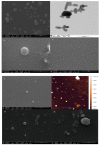New Sustainable Process for Hesperidin Isolation and Anti-Ageing Effects of Hesperidin Nanocrystals
- PMID: 33022944
- PMCID: PMC7582684
- DOI: 10.3390/molecules25194534
New Sustainable Process for Hesperidin Isolation and Anti-Ageing Effects of Hesperidin Nanocrystals
Abstract
Hesperidin, a secondary orange (Citrus sinensis) metabolite, was extracted from orange bagasse. No organic solvents or additional energy consumption were used in the clean and sustainable process. Hesperidin purity was approximately 98% and had a yield of 1%. Hesperidin is a known supplement due to antioxidant, chelating, and anti-ageing properties. Herein, hesperidin application to eliminate dark eye circles, which are sensitive and thin skin regions, was studied. In addition, the proposed method for its aqueous extraction was especially important for human consumption. Further, the most effective methods for hesperidin nanonization were explored, after which the nanoemulsions were incorporated into a cream formulation that was formulated for a tropical climate. Silky cream formulations (oil in water) were tested in vitro on artificial 3D skin from cultured cells extracted from skin residues after plastic surgery. The proposed in vitro assay avoided tests of the different formulations in human volunteers and animals. It was shown that one of the nanonized hesperidin formulations was the most skin-friendly and might be used in cosmetics.
Keywords: anti-ageing; antioxidant; hesperidin; nanocrystals; new-clean process extraction.
Conflict of interest statement
The authors declare no conflict of interest.
Figures





References
-
- Tasic L., Mandic B., Barros C.H.N., Cypriano D.Z., Stanisic D., Schultz L.G., da Silva L.L., Mariño M.A.M., Queiroz V.L. In: Citrus Fruits: Productions, Consumption and Health Benefits. Simons D., editor. Nova Science Publishers; New York, NY, USA: 2016. pp. 27–70. Chapter 2.
-
- Stanisic D., Costa A.F., Cruz G., Durán N., Tasic L. In: Studies in Natural Products Chemistry. Rahman A.-U., editor. Volume 58. Elsevier Science; Amsterdam, The Netherlands: 2018. pp. 161–210. Chapter 6.
MeSH terms
Substances
Grants and funding
LinkOut - more resources
Full Text Sources
Other Literature Sources
Medical

